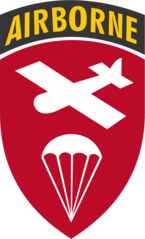The U.S. Army Special Forces traces its roots as the Army's premier proponent of unconventional warfare from purpose-formed special operations units like the Alamo Scouts, Philippine guerrillas, First Special Service Force, and the Operational Groups (OGs) of the Office of Strategic Services. Although the OSS was not an Army organization, many Army personnel were assigned to the OSS and later used their experiences to influence the forming of Special Forces.
During the Korean War, individuals such as former Philippine guerrilla commanders Col. Wendell Fertig and Lt. Col. Russell W. Volckmann used their wartime experience to formulate the doctrine of unconventional warfare that became the cornerstone of the Special Forces.[5][6]
In 1951, Major General Robert A. McClure chose former OSS member Colonel Aaron Bank as Operations Branch Chief of the Special Operations Division of the Psychological Warfare Staff (OCPW) in the Pentagon.[7]
In June 1952, the 10th Special Forces Group (Airborne) was formed under Col. Aaron Bank, soon after the establishment of the Psychological Warfare School, which ultimately became today's John F. Kennedy Special Warfare Center and School. The 10th Special Forces Group (Airborne) was split, with the cadre that kept the designation 10th SFG deployed to Bad Tölz, Germany, in September 1953. The remaining cadre at Fort Bragg formed the 77th Special Forces Group, which in May 1960 was reorganized and designated as today's 7th Special Forces Group.[8]
Since their establishment in 1952, Special Forces soldiers have operated in Vietnam, Cambodia, Laos, North Vietnam, Guatemala, Nicaragua, El Salvador, Colombia, Panama, Haiti, Somalia, Bosnia, Kosovo, 1st Gulf War, Afghanistan, Iraq, the Philippines, Syria, Yemen, Niger and, in an FID role, East Africa.
- ^ 1ST Special Service Force, Shoulder Sleeve Insignia, U.S. Army Institute of Heraldry, last accessed 27 March 2021
- ^ Emerson, William K. (1996). "51". Encyclopedia of United States Army Insignia and Uniforms. University of Oklahoma Press. ISBN 9780806126227.
- ^ Airborne Command Shoulder Sleeve Insignia, U.S. Army Institute of Heraldry, last accessed 27 March 2021
- ^ U.S. Army Special Forces Group (Airborne), Shoulder Sleeve Insignia, US Army Institute of Heraldry, dated 27 October 2016, last accessed 27 March 2021
- ^ "U.S. Army Special Forces Command (Airborne) History". U S ARMY SPECIAL OPERATIONS COMMAND. Archived from the original on 28 May 2013. Retrieved 2 March 2013.
- ^ Department of the Army (COL Russell W. Volckmann), FM 31-21, Organization and Conduct of Guerrilla Warfare (Washington, DC: GPO, October 1951)
- ^ Officer Efficiency Report, Bank, Aaron, 11 May 1952, Aaron Bank Service Record, National Military Personnel Records Center, St. Louis, Missouri
- ^ "U.S. Army Special Forces Command (Airborne) History". U.S. ARMY SPECIAL OPERATIONS COMMAND. Archived from the original on 28 May 2013. Retrieved 2 March 2013.




